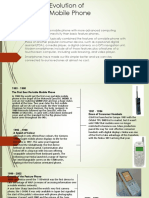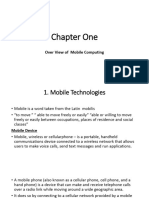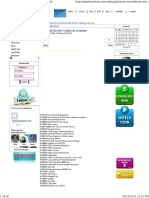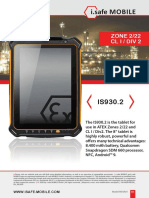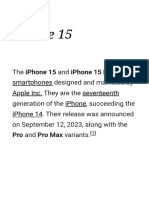The Evolution of the Smartphone: A Chapter in Modern History
The smartphone, a device now seemingly indispensable to modern life, represents one
of the most rapid and profound technological evolutions in human history. Far more
than just a phone, it is a pocket-sized supercomputer, a camera, a navigation
system, an entertainment hub, and a gateway to global information and
communication. Its journey from a niche business tool to a ubiquitous personal
assistant is a testament to relentless innovation and shifting societal needs. This
chapter explores the fascinating trajectory of the smartphone, from its clunky
ancestors to the sleek, intelligent devices we carry today.
The Seeds of Convergence: Early Attempts (1990s)
The concept of combining telephony with computing power wasn't new, but the
technology to make it practical was slow to mature. The 1990s saw the emergence of
Personal Digital Assistants (PDAs) like the PalmPilot and Apple Newton. These
devices offered calendaring, contacts, notes, and sometimes even basic email, but
lacked integrated cellular capabilities. They were distinct from phones, serving a
different, albeit overlapping, purpose for professionals.
However, a pivotal, albeit commercially unsuccessful, device emerged in 1994: the
IBM Simon Personal Communicator. Often cited as the world's first true smartphone,
the Simon combined a mobile phone with PDA features. It had a monochrome LCD
touchscreen, could send and receive faxes and emails, and even featured a few
built-in applications like a calendar, address book, world clock, and notepad. It
even had a slot for third-party applications, though none were ever developed.
Despite its visionary features, the Simon was bulky, expensive ($899 with a two-
year contract), and had poor battery life, leading to its quick discontinuation. It
was ahead of its time, a glimpse into the future rather than a product for its
present.
Towards the end of the decade, feature phones began incorporating more advanced
functions. Nokia's Communicator series, starting with the 9000 in 1996, offered a
clamshell design that opened to reveal a QWERTY keyboard and a larger screen,
providing email, web browsing, and basic office applications. These were powerful
for their era but still lacked the intuitive, integrated experience that would
define the smartphone.
The Rise of the "Smart" Phone: Early 2000s
The early 2000s marked a significant period where "smart" features became more
common in mobile phones, primarily targeting business users.
BlackBerry, introduced by Research In Motion (RIM), became synonymous with mobile
email. Devices like the BlackBerry 5810 (2002) integrated a phone with a full
QWERTY keyboard and push email capabilities, making them indispensable for
corporate professionals. While not touchscreen-centric, their secure communication
and efficient messaging defined a generation of mobile productivity.
Concurrently, companies like Palm (with its Treo line) and devices running
Microsoft's Pocket PC (later Windows Mobile) attempted to bridge the gap between
PDAs and phones. The Palm Treo 600 (2003) was particularly influential, combining a
phone, email, web browser, and a full keyboard in a relatively compact form factor.
These devices often ran on operating systems that allowed for third-party
application installation, albeit through cumbersome methods compared to modern app
stores. They offered a more open, albeit less refined, computing experience on the
go.
These devices laid crucial groundwork, familiarizing users with the idea of a phone
that could do more than just make calls and send texts. However, they were often
complex, had fragmented user experiences, and generally required a stylus for
navigation. The mobile internet experience was slow, expensive, and often limited.
�The Revolution: The iPhone and Android (2007 onwards)
The year 2007 is widely regarded as the inflection point in smartphone history,
largely due to the introduction of the Apple iPhone. Steve Jobs unveiled a device
that was revolutionary not just for its features, but for its seamless integration
and user experience. The iPhone discarded the physical keyboard in favor of a
multi-touch interface, allowing users to interact directly with content using their
fingers. Its intuitive operating system (iOS, then iPhone OS), full web browser,
and integrated iPod functionalities redefined expectations for mobile devices.
Crucially, the App Store, launched in 2008, transformed the smartphone into an
extensible platform. Developers could create and distribute applications directly
to users, unleashing an explosion of innovation and utility. This ecosystem
approach, where hardware, software, and a vibrant app marketplace were tightly
integrated, was a game-changer. The iPhone's success forced competitors to rethink
their strategies.
Google, which had been developing its own mobile operating system, Android, quickly
pivoted after the iPhone's launch. Android's open-source nature allowed various
manufacturers (HTC, Samsung, Motorola, etc.) to adopt it, leading to a rapid
proliferation of diverse smartphone models across different price points. The first
Android phone, the HTC Dream (T-Mobile G1), was released in late 2008, featuring a
physical keyboard and a touchscreen.
The competition between iOS and Android fueled unprecedented innovation. Both
platforms rapidly evolved, adding features, improving performance, and expanding
their app ecosystems. This era saw the smartphone transition from a luxury item for
early adopters to a mass-market device.
Feature Explosion and Ubiquity (2010s)
The 2010s witnessed an incredible acceleration in smartphone capabilities and their
integration into daily life.
Cameras: From basic point-and-shoot quality, smartphone cameras rapidly advanced,
incorporating multiple lenses, optical image stabilization, computational
photography, and high-resolution video recording. The smartphone became the primary
camera for most people.
Processors and Performance: Mobile processors became incredibly powerful, enabling
complex applications, high-fidelity gaming, and seamless multitasking. RAM and
storage capacities also grew exponentially.
Screen Technology: Displays evolved from small, low-resolution LCDs to large,
vibrant AMOLED screens with high resolutions, improved color accuracy, and
eventually, edge-to-edge designs.
Connectivity: The rollout of 4G LTE enabled faster mobile internet speeds, making
streaming video, cloud services, and real-time communication practical on the go.
5G began its rollout towards the end of the decade, promising even greater speeds
and lower latency.
Sensors and Capabilities: Accelerometers, gyroscopes, GPS, NFC (for mobile payments
like Apple Pay and Google Pay), fingerprint scanners, and facial recognition became
standard features, enabling a vast array of new applications and interactions.
Artificial Intelligence: Voice assistants like Siri, Google Assistant, and Alexa
became integrated, allowing for hands-free control and information retrieval. AI
also began to power features like predictive text, photo enhancements, and
personalized recommendations.
�The smartphone became the central hub for digital life, replacing dedicated devices
like MP3 players, GPS navigators, portable gaming consoles, and even basic laptops
for many tasks. Its omnipresence led to new social phenomena, from the rise of
social media platforms accessed primarily via mobile to the "always-on" culture.
The Present and Future: Refinement and New Frontiers
Today, smartphones are mature devices, with incremental improvements in camera
technology, battery life, and processing power being the norm. However, innovation
continues in several key areas:
Foldable Phones: Devices like the Samsung Galaxy Fold and Huawei Mate X are
exploring new form factors, offering larger screen real estate in a compact
package, blurring the lines between phones and tablets.
Advanced AI and Machine Learning: On-device AI is becoming more sophisticated,
enabling features like real-time language translation, advanced image processing,
and highly personalized user experiences.
Augmented Reality (AR): Smartphones are increasingly capable AR platforms,
overlaying digital information onto the real world through their cameras, with
applications ranging from gaming to practical tools.
Sustainability and Repairability: As the environmental impact of electronics
becomes more apparent, there's a growing focus on more sustainable manufacturing
practices, longer software support, and easier repairability.
Connectivity: The continued expansion of 5G and the eventual arrival of 6G promise
to unlock new possibilities for cloud computing, IoT, and immersive experiences.
Conclusion
The history of the smartphone is a microcosm of modern technological advancement.
From the ambitious but limited IBM Simon to the sleek, powerful devices of today,
its evolution has been driven by a relentless pursuit of convergence, connectivity,
and user-centric design. The smartphone has not just changed how we communicate; it
has fundamentally reshaped our work, play, learning, and social interactions,
becoming an extension of ourselves and an indispensable tool for navigating the
complexities of the 21st century. Its journey is far from over, and the next
chapters promise even more profound transformations.















